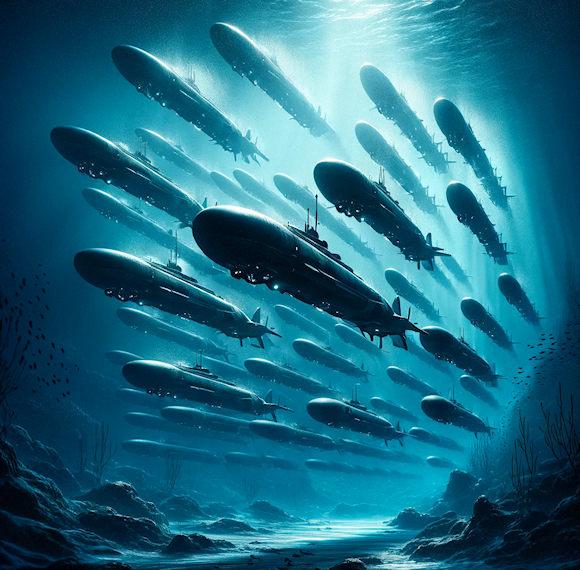Way back in 1880, the then lieutenant Domenico Bonamico wrote: “I energetically protest against this easy tendency to prophesy tactical transformations whenever one of the factors on which tactics function is renewed. If this is a function of the weapons, it is then in the highest degree a function of the nature of the naval forces [...] In my concept the transformation of the weapons can modify the relationships of the attack periods and the areas in which the tactical action is determined, as the evolution of land tactics proves; but to transform the nature of the function and make the properties of its subsequent forms incompatible, never, as such radical innovation can only come from the transformation of the mobile forces and therefore from the nature of the driving force"1.
This long quote from the important Italian naval theorist deserved to be revisited as the latest war events in the world, from the war between Ukraine and Russia, up to the conflict between Israel and Hamas, are generating an important debate on the present and future role of systems unmanned, including naval drones, at war. According to part of the theory, the massive use of drones and the ease of their procurement on the market and adaptability to military contexts, as well as the reduction of maintenance and use costs, would mark the advent of a real revolution both in the tactical and strategic fields, also for the conduct of naval warfare.
The Ukrainian conflict has shown how on land drones still act as a – certainly useful – support tool and cannot, on their own, influence the outcome of a battle or an entire operational cycle. The use of drones therefore remains confined to the purely tactical field. On the air front, however, drones, especially if deployed en masse (as their affordability allows), will continue to dominate the battlefield, while highly advanced and expensive air forces appear virtually powerless to stop them. For ground troops, attacks by masses of drones costing a couple hundred dollars each are as deadly as bombs dropped by enemy fighters worth millions of dollars2.
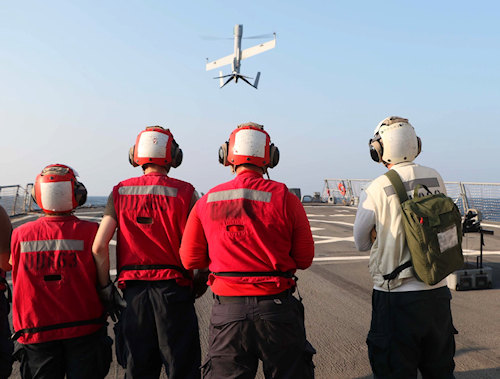 In the maritime domain, systems unmanned include surface naval assets, assets operating below the surface, and air assets3. The Ukrainian war is the first conflict in history where a naval military force composed almost exclusively of small unmanned vehicles - the mosquito fleet - is holding a conventional and far more powerful fleet in check. However, the Russian-Ukrainian naval front requires a more in-depth analysis to truly understand what the usefulness of marine drones is in the specific context of the Black Sea.
In the maritime domain, systems unmanned include surface naval assets, assets operating below the surface, and air assets3. The Ukrainian war is the first conflict in history where a naval military force composed almost exclusively of small unmanned vehicles - the mosquito fleet - is holding a conventional and far more powerful fleet in check. However, the Russian-Ukrainian naval front requires a more in-depth analysis to truly understand what the usefulness of marine drones is in the specific context of the Black Sea.
Naval warfare in the Black Sea
After the loss of Sevastopol following the Russian occupation of Crimea in 2014, with the consequent loss for Ukraine of 70% of its naval vessels and their crews, the final blow to the Ukrainian navy, the Vijs'kovo-mors'ki syly (VMS), was given by Russia's conquest of the ports of Melitopol and Berdyansk and Snake Island at the beginning of the 2022 war, which practically determined the end of the Ukrainian surface fleet as an organized military component . Yet, with a clever use of the A2/AD strategy, Kyiv managed to prevent the Russians from exploiting their established naval superiority in the Black Sea.
At the outbreak of hostilities, Turkey immediately activated the Montreux Convention, prohibiting the passage into and out of the Black Sea of military shipping from the belligerent countries. The Russians were thus forced to fight in a "closed" space and with limited resources, both in terms of means and weapons and infrastructure. Ukraine was not, however, damaged by the activation of Montreux, as the extension of the operational area of its Navy did not go beyond the Black Sea even before the war and was, therefore, prepared for a type of conflict with certain spatial limits.
Aware of its inferiority, the Ukrainian Navy used an A2/AD strategy4 against the Russian fleet. This strategy is made up of two elements: the first, A2 (anti-access), indicates the implementation of actions aimed at preventing the entry of one's opponent into the domain in question, therefore referring to hindering movement towards it. The second, AD (area denial), refers to the ability to hinder the enemy's movements within the domain in question.

The Ukrainian attempt to wisely apply the A2/AD strategy5 it emerged not so much in actions that led to sensational successes, such as the sinking of the missile cruiser Moskva (14 April 2022), but in developments following the release de facto of Moscow from Black Sea Grain Initiative and the subsequent announcement of a naval blockade of the western Ukrainian coast starting from 17 July 2023.
In the first days of the blockade, the Russian Black Sea Fleet, while staying out of reach of Ukrainian anti-ship missiles, had assumed a deployment suitable for imposing widespread control from Crimea to the Dardanelles.
The high quantity of mines that Russia has placed along the merchant routes to and from Odessa serve to prohibit navigation for Ukrainians and discourage the presence of neutral civilian shipping.
The naval blockade can effectively be carried out in a limited area from Odessa to the mouth of the Danube and the offensive mining of that stretch of sea represents a danger that can potentially block any commercial traffic. In addition to patrols along the sea line from Olenivka to the Danube, Russian forces have hit the main ports of the western coast (Odessa above all) with aerial and missile bombardments and with swarms of drones up to the river port of Izmail. The idea behind this choice by Moscow is linked to the fact that the conventional naval superiority it enjoys can only and exclusively be exploited if Ukraine is put into political crisis, i.e. demonstrating that Kyiv is incapable of guaranteeing the security of grain trade route.
The first objective of the VMS was, therefore, to counter the presence of Russian ships along the "grain route", and then directly attack the enemy fleet in its ports. The A2 type actions were therefore identified in the context of the clashes that occurred in the control waters of the "humanitarian naval corridor", which led to the sinking of a Russian light vessel (mainly KS-701), tasked with patrolling the area and to implement, in the event of identification of neutral merchant ships, the "right of visit"; while those of the AD type were attributable to the Ukrainian bombings, conducted with missiles and swarms of drones, on Sevastopol, which is the main base of the Russian Navy in the Black Sea. Hitting the "brains" of the enemy fleet, as well as its main logistical infrastructure , the Ukrainians attempted, with relative success, to thwart the war plans of Moscow's admirals. Thanks to the use of aerial and naval drones (USVs) and missiles, Ukraine has managed to counterbalance Russia's conventional capabilities in the skies and at sea6.

Although the attention of the main observers and public opinion is directed to land operations - and the Russian-Ukrainian war is by its very nature an intrinsically "continental" conflict - the maritime one remains a central issue, also because the possession of the coast - with minimal hypothesis from the Kherson Oblast to Mariupol, i.e. the current conformation of the occupied zone - is a "strategic problem" for Moscow, which must guarantee itself exclusive control of the Sea of Azov to the east, placing a serious threat also on Odessa, West.
Drones in operations in the Black Sea
Using Bonamico's analysis scheme on the differences between offensive and defensive fleets and adapting it to today's situation, the naval drone is the weapon that allows an inferior Navy forced to defend itself, the Ukrainian one, to fight almost on equal terms with a counterpart devoted to the offensive.
The use of the "mosquito fleet" of naval drones allowed the Ukrainians to force the enemy naval blockade and go on the offensive, albeit limited, against the Russian logistics and port infrastructures in Crimea and Sevastopol. Conventional shipping was, however, entrusted with the task of escorting merchant convoys and identifying any Russian patrol boats along the control and application routes of the naval blockade. The extensive use of naval drones by Ukraine has also forced the Russians to use a strategic strategy fleet in existence, aimed at protecting the integrity of its larger units, but which does not allow it to fully exploit its superiority in terms of tonnage, firepower and projection capacity.
In strictly doctrinal terms, a war is being fought in the Black Sea in which both belligerent powers have chosen, Ukraine out of calculation, Russia out of de facto forced, to adopt a strategy of sea denial. In the Ukrainian case, denying the sea to the Russian Black Sea Fleet means protecting its own trade routes - even if reduced to the bare bones, but what also counts, in this specific case, is the political message that Kyiv intends to send to the Western allies and the rest of the world - but also to prevent the enemy from being able to pour its concentrated power into the stretch of sea still controlled by the "corsair" VMS. In the Russian case, keeping its largest ships in ports is the guarantee that the Ukrainian fleet can never attempt to fight a decisive battle.
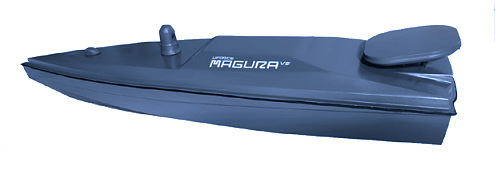
The sea denial strategy also allows a smaller fleet to be able to strike much easier forces in combined joint operations, which today mainly concern the use of missiles or aerial drones directed against enemy bases and infrastructures.
This is due, as already written, to the Ukrainian need to counterbalance, by conducting "innovative" conventional warfare actions, the greater projection capabilities of enemy forces. Furthermore, marine drones are one of the emblematic cases - a case study for the Russian-Ukrainian war - of instruments created for civilian use and reconverted as weapons. Generally in the history of humanity the opposite has always happened. USVs, created for purposes such as environmental monitoring and protection of the marine ecosystem7, have become weapons which, produced at relatively low cost and in large quantities, can cause significant damage to the enemy, also forcing him to change his posture.
Although they have substantial flaws, such as onboard sensors with a narrow field of view - which makes it difficult to track moving targets without accurate position data or detect camouflaged ships - and the need for constant communications, which makes the presence of a good connection mandatory, naval drones are used, like aerial ones, in a "swarm", and are one of the fundamental components of that "mosquito fleet", a new concept of tactical unit developed by the Ukrainian Navy to fight, like a new David, the Russian Goliath anchored in Sevastopol.
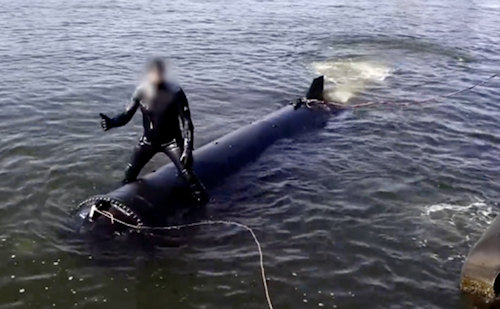 A fairly widespread opinion is that, in addition to clear tactical implications, the conduct of the "corsair" drone war by Ukraine has induced notable strategic changes that have caused the Russian "functional defeat" in this phase of the naval war in the Black Sea8. In fact, the conduct of the "mosquito fleet" operations in the Black Sea has shown all the importance of naval drones to continue fighting, also inflicting significant damage on the enemy, for a fleet that no longer has its own real conventional capability. In this regard, it is worth highlighting that, if changes have occurred at the operational level, the same cannot be said to have occurred at the broader strategic level.
A fairly widespread opinion is that, in addition to clear tactical implications, the conduct of the "corsair" drone war by Ukraine has induced notable strategic changes that have caused the Russian "functional defeat" in this phase of the naval war in the Black Sea8. In fact, the conduct of the "mosquito fleet" operations in the Black Sea has shown all the importance of naval drones to continue fighting, also inflicting significant damage on the enemy, for a fleet that no longer has its own real conventional capability. In this regard, it is worth highlighting that, if changes have occurred at the operational level, the same cannot be said to have occurred at the broader strategic level.
The actions carried out against Russian patrol boats along the north-western coast of the Black Sea or directly against the port of Sevastopol or the Kerch bridge have "forced" the Russians to adopt, as already mentioned, a "powerful fleet" posture; but if you get out of the narrow Operationstheater9 Clausewitzian, to enter the political-strategic sphere, it will be possible to note how the Russian objective of strangling Ukrainian maritime trade has, in essence, been achieved. Even with the safe maintenance of the "humanitarian maritime corridor" of the grain route, the quantity of goods exported has decreased and costs have increased, also due to the obligation to seek alternative routes to the sea for the transit of goods.
An Italian “mosquito fleet”?
Faced with an initial almost "artisanal" phase of use of civil drones reconverted for military use, now the sector, in the wake of the successes in the use of these systems in the "innovative" maritime warfare of the VMS, is evolving and has made various types of naval drones available to the navy, such as the Magura or Sea Baby surface attack ones, or the Toloka TK-150 and Marichka submarine ones. From a purely military point of view, the progress made in the field of underwater drones has also concerned the navies of Western states, including the Italian one, which on the basis of the "experiences" gained from the observation of the Russian-Ukrainian conflict are evaluating the possibility of ever greater integration between submarines and assets unmanned10, as well as the Future Combat Naval System 203511 of the Navy explained.
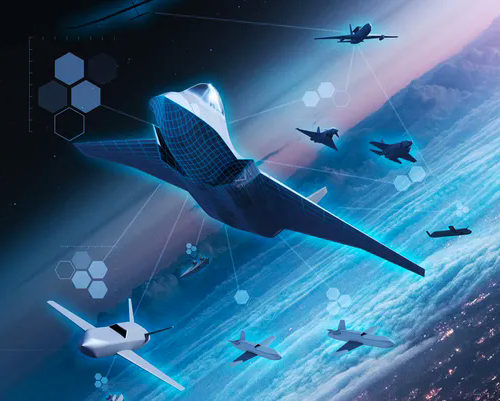 It is, essentially, a naval equivalent of what should be, within the Italian-Anglo-Japanese GCAP program, the multi-role fighter Tempest at the aerial level. The GCAP program involves not only the development of the aircraft itself and its weapons systems, but also of systems unmanned complementary and integrated, intended for combat and combat support operations, controlled by the pilot through what has been defined as "swarm intelligence"12. In other words, GCAP is a program that aims to develop a "system of systems" that can not only compete but provide a real advantage to users in modern multi-domain conflicts, therefore well beyond a "simple aircraft".
It is, essentially, a naval equivalent of what should be, within the Italian-Anglo-Japanese GCAP program, the multi-role fighter Tempest at the aerial level. The GCAP program involves not only the development of the aircraft itself and its weapons systems, but also of systems unmanned complementary and integrated, intended for combat and combat support operations, controlled by the pilot through what has been defined as "swarm intelligence"12. In other words, GCAP is a program that aims to develop a "system of systems" that can not only compete but provide a real advantage to users in modern multi-domain conflicts, therefore well beyond a "simple aircraft".
Il Future Combat Naval System it must represent, also as a function of the technological challenge that is involving States also in the military sphere and which, in fact, has "hybridized" the threats, the connecting element between the aerospace and underwater domains, in order to protect the component naval of the Armed Forces. Thus, while ships, submarines and aircraft will have to transform themselves into real strategic hubs, easily deployable and capable of exploiting the peculiarities of the maritime domain13 - global
Common but, now, highly "territorialized", therefore subject to widespread conflicts - ever greater attention must be paid to the dimension unmanned.
Among the first navies in the world to have understood the importance of Manned UnManned-Teaming (MUM-T), the Italian one has also worked on transformation, evident if we consider that the class Ardito has approximately 400 men and women for a 5.000 t ship, while the next class Doria/Horizon increased tonnage to 7.000 t while halving the crew14, of their ships following these directions.
The Italian Navy, following the majority naval thinking in the West, aims to integrate its conventional fleet with systems unmanned, with the aim of building "hybrid" units, capable of responding operationally to any eventuality. It is clear that this is an optimal choice for a naval force perfectly integrated into the structure of the Atlantic Alliance and that, in the event of a conflict, it would not only find itself having a leading role, also given Italy's importance in Mediterranean context, but also to have to contribute to the common effort, without ever risking finding ourselves fighting an isolated war, as happened to Ukraine.
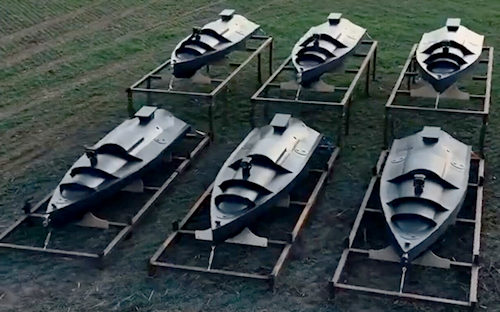 The almost complete "droneization" of the Ukrainian Navy is the result of a specific historical period, that of the ongoing war against Russia, which would have required the cessation of any clash at sea if Kyiv had not knowingly chosen to organize its maritime military component in differently compared to 2014, but also compared to the enemy. Furthermore, it is necessary to consider the establishment and strengthening of the naval component unmanned Ukraine was already an integral part of Kyiv's strategy, as set out in the 2019 document signed by Admiral Igor Voronchenko15, in which "droning" constitutes one of the most important phases of the reconstruction of a fleet capable of fighting a war along the coasts of the Black Sea coast.
The almost complete "droneization" of the Ukrainian Navy is the result of a specific historical period, that of the ongoing war against Russia, which would have required the cessation of any clash at sea if Kyiv had not knowingly chosen to organize its maritime military component in differently compared to 2014, but also compared to the enemy. Furthermore, it is necessary to consider the establishment and strengthening of the naval component unmanned Ukraine was already an integral part of Kyiv's strategy, as set out in the 2019 document signed by Admiral Igor Voronchenko15, in which "droning" constitutes one of the most important phases of the reconstruction of a fleet capable of fighting a war along the coasts of the Black Sea coast.
Furthermore, consider that what Voronchenko set out was a long-term process, which should have led Ukraine to have a fleet capable of defending its national interests well beyond the Black Sea by 2035, following, in good substance, the teachings of Blue Water School. The first phase of the reconstruction of the Navy was to be completed by 2025; process blocked halfway by the outbreak of the war against Russia and which led to an organic but also interpretative "distortion" in the composition of the VMS.
As already written, the “mosquito fleet” was a requirement for the Ukrainian Navy16, also favored by the particular "closed sea" context in which the war in the Black Sea is fought and which in other contexts would probably not have achieved the same important results. This is why this model cannot be taken up in all respects by a Navy like the Italian one but, more generally, by any naval instrument that still has both its offensive and defensive potential intact.
In this respect, the procurement choices and changes in the US Navy's equipment are emblematic. In 2022 the Department of the Navy released a request for information for the Attritable UxV Mother Ship (Aums) program, better known as "mother of drones". From the US Navy's perspective, Aums represents a cost-effective solution for deploying a large number of drones in a contested environment17. The Aums program would act as support to "traditional" US shipping in an operational context clearly identified in the Indo-Pacific and, specifically, in the choke points Chinese, where the Beijing Navy could attempt to implement, as has already emerged at the theoretical-strategic level, an A2/AD conduct. In the case of the US Navy, drones should play an important "saturation" role in the theater of naval and air operations.
In a vast environment like that of the wider Mediterranean18, MUM-T integration becomes essential for the Navy, as well as a tool that would allow it to increase its capabilities in intelligence surveillance & rconnaissance (ISR), submarine warfare, mine hunting and special operations, transport and logistics, reducing costs in terms economic for maintaining a capillary control of the sea and its defense, also increasing its general power coefficient.
1 D. Bonamico, The first elements of maritime warfare carried out at the Higher War School, Turin, Tipografia Operaia, 1880, p. 140, now in D. Bonamico (edited by F. Botti), Writings on Sea Power (1894-1905), Rome, Historical Office of the Navy, 1998, p. 38
2 D. Barno and N. Bensahel, Learning from real wars: Gaza and Ukraine, in War on the Rocks, https://warontherocks.com/2023/12/learning-from-real-wars-gaza-and-ukraine/, 06 / 12 / 2023
3 P. Barberini, The development of maritime unmanned systems, in Rivista Marittima, Rome, May 2022, p. 29
4 A. Krepinevich, B. Watts and R. Work, Meeting the Anti-Access and Area-Denial Challenge, Center for Strategic and Budgetary Assessments, 2003
5 G. Chiacchio, The use of the Ukrainian A2/AD strategy in the battle for the Black Sea, in Geopolitica.info, https://www.geopolitica.info/a2-ad-russia-ucraina-mar-nero/, 13 / 04 / 2023
6 F. Del Monte, A fleet of drones. The “guerrilla war” in the Black Sea, in Geopolitica.info, https://www.geopolitica.info/una-flotta-di-droni-la-guerra-di-guerriglia-nel-mar-nero/, 13 / 10 / 2023
7J. Cheetham, Sea drones: What are they and how much do they cost?, on BBC, https://www.bbc.com/news/world-europe-66373052, 13 / 09 / 2023
8 D. Minzarari, The Strategic Implications of Ukraine's Strikes in the Black Sea, Royal United Service Institute-RUSI, 2023
9 This is apparently only a theoretical problem but it has a direct influence on the analysis of the changes that a war can generate. In Book V Chapter 2 of “Vom Kriege” (1832), Clausewitz deals with the strategic level of war, identifying it with what contemporary theory would identify as the operational level. It is a central question to understand how much the use of drones has actually influenced the strategic transformations of the naval theater in the Black Sea.
10 A. Marrone, The underwater dimension: critical infrastructures, drones and underwater warfare, in Rivista Marittima, Rome, July-August 2023, p. 57
11 Navy, The Future Combat Naval System 2035 in multi-domain operations, 2021
12 F. Del Monte, The "Saudi thread" that binds GCAP and Eurofighter, in Online Defense, https://www.difesaonline.it/industria/il-filo-saudita-che-lega-gcap-e-eurofighter#google_vignette, 03 / 11 / 2023
13 Navy, The Future Combat Naval System 2035 in multi-domain operations,
14 A. Marrone, Unmanned vehicles in the maritime domain: prospects for Italy, in the Italian Defense Journal-RID, https://www.rid.it/shownews/5474/i-mezzi-unmanned-nel-dominio-marittimo-prospettive-per-l-rsquo-italia, 01 / 02 / 2023
15 I. Voronchenko, Strategy of the Naval Forces of the Armed Forces of Ukraine 2035, Ukrainian Navy, 2019
16 Ukraine's latest requests to Western partners for naval forces go along these lines: aerial drones, unmanned surface and underwater vessels, naval circuit munitions.
17 G. Chiacchio, A mothership for drones: the US Navy's weapon to armor Taiwan, in Inside Over, https://it.insideover.com/difesa/nave-madre-droni-arma-marina-usa-taiwan.html#google_vignette, 17 / 05 / 2023
18 E. Credendino, Navy, national interests and the wider Mediterranean, in GNOSIS, 1/2023
Photo: OpenAI/US Navy/X/web/Bae Systems

